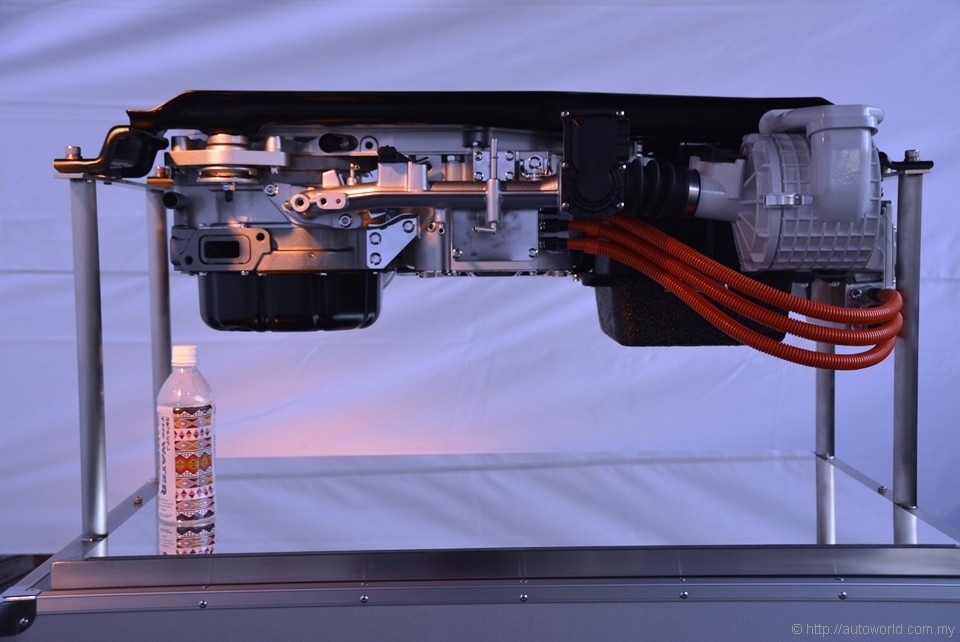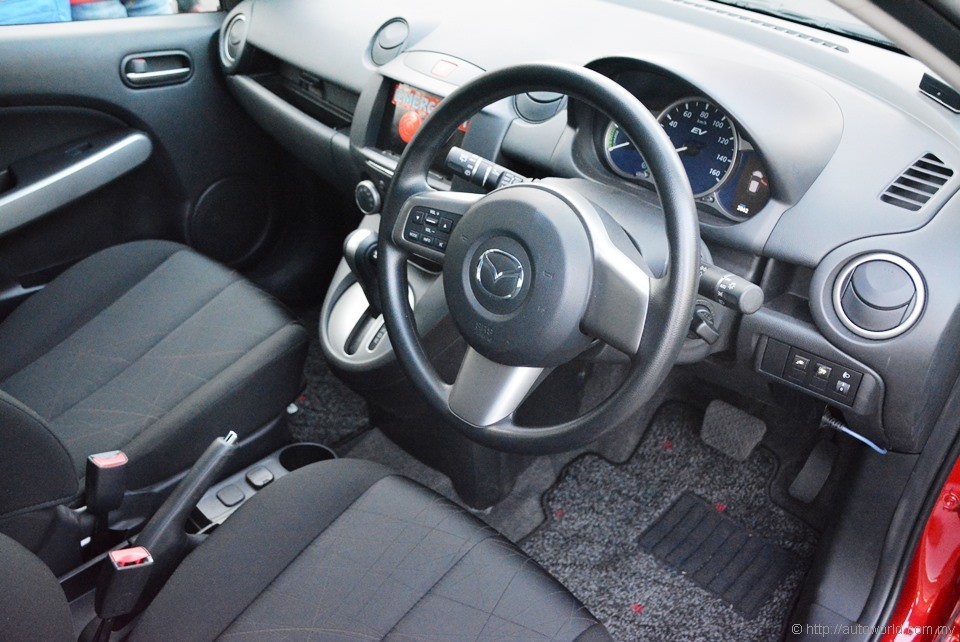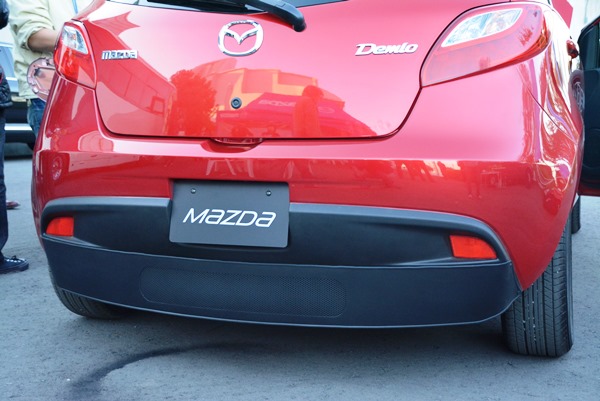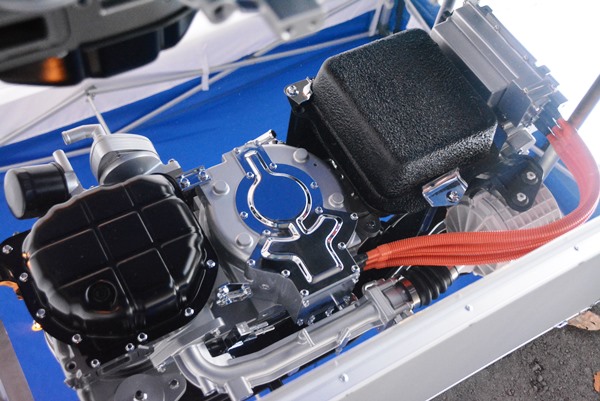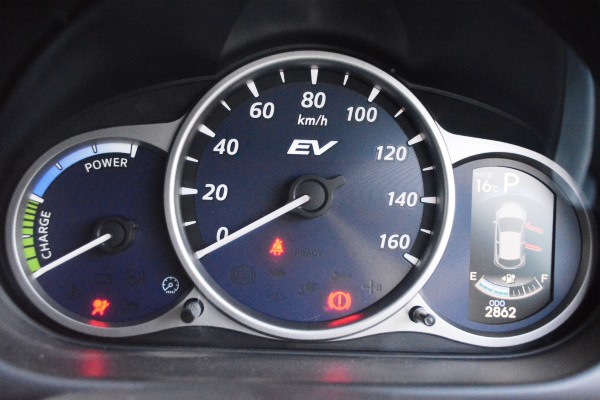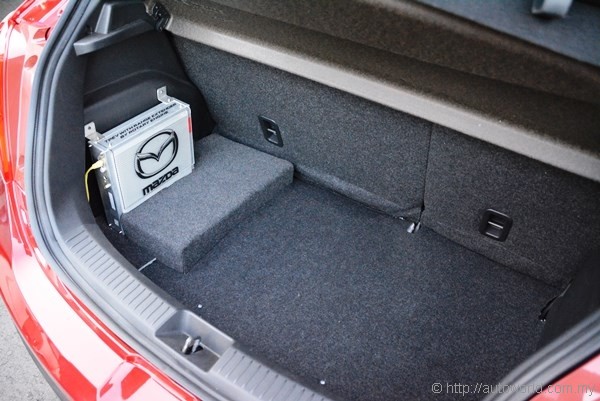Mazda2 EV Prototype tested in Yokohama, Japan
Despite forecasting that 90% of the world’s transportation will continue to be powered by internal combustion, forward-thinking Mazda has not been foolish enough to neglect exploring development of its own electric vehicle. In 2012, the company rolled out a leasing programme involving 100 electric vehicles targeted at local governments and corporate customers in the vicinity of Mazda’s global HQ in Hiroshima.
Looking no different from the Mazda2 which we are familiar with, the Mazda Demio EV has a 346V 20kWh lithium-ion battery pack attached under its floor board supplying electricity to a front-mounted electric motor. Sourced from an unnamed third party which Mazda officials refused to disclose, the motor produces 101hp @ 5,200 – 12,000rpm and 150Nm @ 0 – 2,800rpm, similar outputs to naturally aspirated 1.6-litre engines, albeit spread over a wider range of revs.
Internal testings by Mazda based on the Japanese JC08 cycle project an impressive driving range of 200km per full charge. The company’s product release dated July 2012 quote a maximum charging time of eight hours, but with the vehicle being in developmental stage, that time could easily have been shortened by now.
Through the leasing programme, Mazda was able to gather a considerable amount of feedback to push its electric vehicle development closer to commercial readiness. Unsurprisingly, one of the key issues that surfaced related to the limited driving range of the vehicle. Mazda found that despite the EV’s available driving range being more that adequate the service the actual daily usage of most users, some 42% of users in the programme reported dissatisfaction over the vehicle’s driving range, whilst a further 28% said they were ‘sort of dissatisfied’.
With this feedback in mind, Mazda went back to the drawing board with the aim of resolving the range issue preferably with a solution that is able to fit within the existing infrastructure framework. The immediate and obvious answer to the problem is a range extender, which is to use an internal combustion engine to serve as an onboard generator to replenish the battery’s charge when needed. For the uninitiated, it is important to draw the distinction between a range extender and the regular hybrid vehicles that are currently in use today; in a range extender, the combustion engine does not supply drive power.
The combustion engines in range extender EVs are typically small, and they often operate at a fixed engine speed calculated to be the engine’s most optimum in terms of energy generation and fuel consumption. The BMW i3, for example, offers the option of a 647cc two-cylinder range extender while GM’s Chevrolet Volt has a 1.4-litre four-pot that serves the same function. Compact dimensions and energy efficiency are therefore key requirements of a range extender generator, and for Mazda, the company has a ready-made answer to these requirements – the rotary engine.
Mazda’s range extender solution comes in the form of a 330cc single rotor rotary engine generating 22kW @ 4,500rpm, with a full system potential of 28kW @ 6,000rpm. The motor is in turn connected to a generator by belt to churn out a continuous output of 20kW. To give the vehicle a more natural feel, Mazda mapped the engine to adjust its revs according to driving speed, thus giving the familiar sensation of engine revs increasing with acceleration.
In order to realize a more compact packaging, Mazda’s engineers designed the motor to be mounted horizontally, giving the motor-generator assembly an incredibly thin height. The assembly is in fact so compact it can be mounted on the underside of a Mazda2 hatchback behind its rear axle with no structural modifications. Another advantage of the horizontal layout is that the system’s vibrations are mostly in the horizontal direction which allows Mazda to use stiffer vertical mounts to support the motor’s weight and dissipate vibrations using soft horizontal padding.
Sidetracking a little, the rotary range extender’s incredibly compact dimensions and decent outputs also gave Mazda the idea of creating a portable generator powered by the same rotary engine, which can match the outputs of bulky diesel generators but be contained within the compact weight and dimensions typically associated with petrol generators. Mazda has yet to seriously explore the business case for this yet, but the commercial potential is there – a rotary generator weighing around 100kg pushing out 15-20kW of outputs, as opposed to a 5.5kW petrol generator of similar weight or a 20kW diesel weighing 580kg.
Our visit to the Tokyo Motor Show last week included a side programme at Yokohama where we had the opportunity to try out a Mazda2 EV prototype fitted with the aforementioned rotary range extender. With each journalist given only two laps around a small patch of tarmac no bigger than your average office car park, firm conclusions are impossible to draw, but a number of characteristics stood out.
The overall driving experience is pleasant and true to promise, the rotary engine noticeably revs up as you accelerate. The engine’s start/stop cycle is well-executed, being perceptible only if you are deliberately waiting to hear and feel it. It is otherwise unobtrusive. Another pleasant aspect is smooth deceleration, which is not often found in EVs and hybrids with regenerative braking. Mazda took deliberate care to eliminate the abrupt and often disconcerting jerks that are the typical habits of these vehicles when the accelerator is released.
Given the age of the current generation Mazda2, it is highly unlikely that the prototype we tested will make it into production as we see it here. But take nothing away from the brilliant simplicity of the concept that Mazda is seeking to present – a compact and efficient range extender that can be readily packaged into any of its existing or future models without too much compromise. It is a highly workable solution that fits elegantly into our existing infrastructure framework. This is one development worth keeping tabs on.






